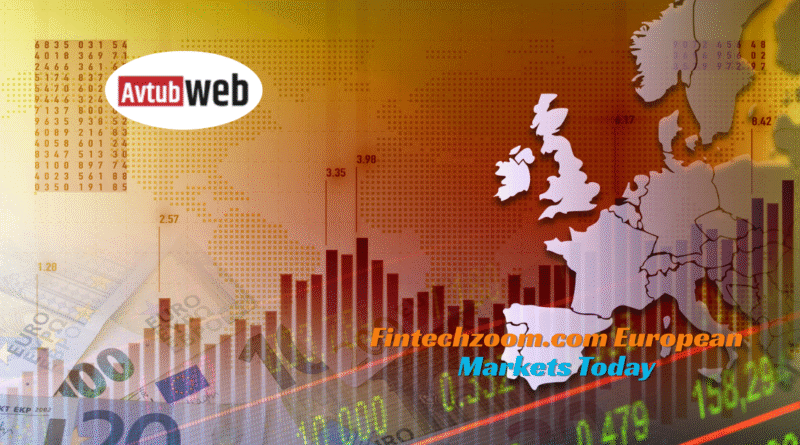Fintechzoom.com European Markets Today explain key stock movements
When you check Fintechzoom.com, European Markets Today explains key stock movements; you’re tapping into a window of real‑time insight into how the European markets are performing and why that matters beyond the continent. In this article, we’ll walk through the major European indices like the FTSE 100, DAX 40, CAC 40, Euro Stoxx 50, and IBEX 35, highlight which European stocks are the current top gainers and top losers, and explore the forces‑at‑play: from inflation data, interest rates, currency movement such as Euro/USD and GBP/USD, to sector performance in banking, energy, technology, automotive, pharma and luxury stocks.
We’ll also consider how global markets—including Wall Street and Asian markets—interact with Europe, how geopolitical risks and commodity markets like oil prices and natural gas feed into the picture, and finally, what this all means for your investment insights and trading strategies.
Overview of European Stock Markets Today
The European economy is holding a complex position right now: the European markets reflect both cautious optimism and underlying fragility. The Euro Stoxx 50 recently rose to about 5,647 points on 10 November 2025, gaining approximately 1.45% compared to the previous session. At the same time, industrial production across the euro area dropped by 1.2% in August 2025 compared with July, indicating some weakness in manufacturing output. These mixed signals show that the stock index performance and the real economy are not entirely aligned, which increases market volatility. For investors focusing on market trends, this means watching the gap between headline index moves and the underlying economic data is essential.
Top Gainers and Losers in European Markets
Identifying the leading and lagging companies in the European markets can shed light on where momentum is happening and where risks lie. In recent weeks, stocks tied to growth areas such as cloud computing and luxury goods have pulled ahead, while heavy‑industry and energy companies are feeling headwinds from supply chain and commodity‑price pressures. Although specific company statistics for the day aren’t always publicly aggregated, recent reporting suggests that markets are sensitive to corporate earnings, sector shifts, and currency changes. For anyone tracking stock performance in Europe, filtering the top gainers (growth‑oriented) and top losers (cyclical, commodity‑linked) helps clarify where to position in short‑term trends and long‑term trends.
Sector Performance Breakdown
Across Europe, sectors are diverging. The banking sector is seeing some positive moves as interest rates remain elevated. The energy sector is under pressure due to weak commodity prices and supply concerns. The technology sector is gaining attention, especially companies expanding into cloud and AI, whereas the automotive sector is cautious because of export weakness and EV competition. The pharma sector remains a defensive play while luxury stocks are gaining on a rebound in Asian demand. For example, manufacturing output in the euro area grew only modestly—1.1% year‑on‑year in August, signalling limited momentum. If you’re watching the market pulse, a sector breakdown helps reveal where the money is going (or leaving) within the European markets.
Explore our post — DigitalConnectMag.com Explained — for in‑depth insights into tech, business, and IT.
Macro Drivers of European Markets Today
The backdrop to all of this is governed by key macro factors. Inflation expectations in the eurozone fell to about 2.10% in October 2025. The European Central Bank (ECB) is keeping policy steady, while the Bank of England (BoE) continues to monitor UK inflation closely. For example, German inflation rose to 2.1% in August. These figures influence investor expectations about interest rates and corporate earnings, and ripple into asset prices. Investors watching market drivers today need to track how the European debt markets, Eurozone policy, and UK policy tie into everyday trading strategies.
Forex & Currency Markets
Currency movements impact company earnings, import/export balances, and thereby the European stocks landscape. The Euro / USD pair, around 1.08, signals a relatively weak euro, which helps exporters but may squeeze companies relying on imported inputs. Meanwhile, the GBP / USD near 1.26 shows a stabilized but watchful UK currency. A weaker euro often gives European exporters an edge, while currency hedging becomes more relevant for global investors. For those focusing on global capital flows, these currency moves feed straight into how European markets behave in relation to Wall Street and Asian markets.
Bond & Debt Market
Yields in Europe are sending important signals about risk and investor confidence. For example, the German Bund yields are climbing, suggesting inflation and growth concerns. Spread widening between Italian BTPs and German Bunds points to heightened risk perceptions around European debt and how markets view fiscal health. When bond yields rise, equity valuations can come under pressure, especially in sectors with high debt or underperforming fundamentals. This feeds directly into the risk management conversation for investors in the European economy.
Geopolitical & Global Pressures
Geopolitical tension remains a significant influence on the European markets. The war in Ukraine continues to strain energy supply and boost dependence on imports. Meanwhile, China‑EU trade frictions reduce demand for European exports, and tighter US Fed policy increases global borrowing costs and risk‑off sentiment. Such pressures ripple through commodity markets, corporate earnings, and investor sentiment, making them part of the market outlook for both the short-term and long-term.
Explore our post — BlogsterNation.com Explained — to learn how this platform helps creators grow their blogs and monetize fast.
Investor Psychology
Even with all the numbers, market moods matter. Investor sentiment in Europe has tilted between risk‑on and risk‑off moments depending on headlines—from IPO highlights to digital finance disruptions. Retail investors are increasingly using trading apps, while institutions adjust hedging strategies. This mix contributes to trading volume spikes and sometimes exaggerated moves in market volatility. For U.S.‑based readers watching Europe, keeping an eye on sentiment helps anticipate where the market might head rather than simply reading the soup of data.
Europe vs US & Asia: Comparative Lens
When U.S. investors look across the Atlantic, the European markets offer something different compared to the U.S. and Asia. While Wall Street may dominate headlines and Asian markets capture growth stories, Europe offers potential value in sectors that have been overlooked or under‑weighted. For example, in Europe, manufacturing output in the euro area shows only 1.1% year‑on‑year growth in August 2025. That suggests performance may be compressed relative to U.S. or Asian benchmarks, but opportunity may exist for patient investors. The comparison theme is especially helpful when setting a global investment mix.
ETFs & IPO Highlights
If you prefer broader exposure rather than single‑stock bets, European ETFs are worth noting. Funds tracking indexes like the Euro Stoxx 50 or STOXX Europe 600 offer diversified access to the European indices. The STOXX Europe 600 covers about 90 % of the free‑float market cap in Europe. IPOs in European financial hubs are gradually reviving after a lull, offering fresh entry points for investors watching digital transformation and Fintech startups. For any investor in U.S. markets looking toward Europe, these vehicles make participation easier.
ESG & Green Transition
The European economy is front and center in terms of ESG investments and green energy transition. The energy sector is being reshaped as Europe moves away from dependence on Russian gas and leans into renewables. Companies engaged in wind power, solar energy, and sustainable infrastructure are gaining attention. These structural changes feed into the long‑term trends of the region and help explain why some investors may favour European over other markets for growth beyond the next year.
Fintech & Digital Transformation
Alongside traditional sectors, the rise of Fintech startups and digital finance in Europe is worth noting. Platforms like Fintechzoom.com offer real‑time data and insights, lowering the barrier for everyday investors. As Europe’s financial infrastructure modernizes, growth in trading apps, alternative finance, and digital tools adds a layer of transformation to the market picture. For U.S. readers exploring Europe, this angle may offer a growth‑adjacent theme that’s less covered than tech in the U.S.
Future Outlook
Looking ahead, the market outlook for Europe spans multiple horizons. In the short term, volatility may remain high as earnings, central bank decisions, and commodities fluctuate. In the medium term, sectors such as banking and technology could lead the next leg of growth. The long‑term view points to how structural themes—like low‑carbon transition, digital transformation, and cross‑border investment flows—will define success for the European markets. Monitoring macro data, market performance, and structural shifts will help shape how you engage with Europe.
Explore our post — AnalyzingMarket.com Explained — to uncover how this platform delivers market insights and analysis.
Frequently Asked Questions (FAQs)
What are European indices like FTSE 100, DAX 40, CAC 40, Euro Stoxx 50, and IBEX 35?
These are benchmark stock indices that track the performance of large companies within European markets. For example, the FTSE 100 reflects the top 100 companies on the London Stock Exchange, and the DAX 40 tracks Germany’s top 40 firms. By watching these indices, you get a quick sense of how the European economy and corporate sector are performing.
How does currency movement, like Euro/USD or GBP/USD, affect European stocks?
When the euro weakens versus the USD, European exporters become more competitive abroad, potentially boosting their earnings. Conversely, a stronger euro can hold back export‑driven companies. Similarly, GBP/USD changes influence UK‑based firms. So currency shifts are a key part of interpreting European stock movements and global markets.
What role do central banks like the ECB or BoE policy decisions play in European market trends?
The European Central Bank (ECB) and the Bank of England (BoE) set base interest rates, guide monetary policy, and influence inflation expectations. If they signal rate hikes or cuts, that can move banking sector stocks, bond yields, and risk sentiment, which in turn impacts European markets.
Why are corporate earnings and company news important for tracking key stock movements in Europe?
Company‑level performance drives stock returns. When firms like SAP (tech) or LVMH (luxury) beat or miss earnings expectations, the sector may shift accordingly. These micro events feed into broader sector performance and can sway European indices.
How do commodity markets, such as oil prices and natural gas, influence the European economy?
The energy sector in Europe is exposed to fluctuations in oil and natural gas costs. When commodity prices rise, energy companies may benefit, but input costs can hurt other industry players, increasing inflation and affecting market volatility for the region.
What is the difference between short‑term trends and long‑term trends in European markets?
Short‑term trends often relate to day‑to‑day news, earnings, currency swings, or geopolitical headlines. Long‑term trends are about structural change: things like digital transformation, ESG investments, and the shift in the European economy away from legacy sectors. Both matter when setting your investment or trading strategy.
How do ETFs in Europe and IPO highlights help investors gain exposure to the region?
European ETFs offer diversified access to European stocks (for example, via the Euro Stoxx 50 or STOXX Europe 600) without picking individual companies. IPO highlights show fresh companies entering the market, offering growth opportunities. Together they allow investors—even in the U.S.—to participate in global capital flows into Europe.
What is investor sentiment, and why does it matter for European markets today?
Investor sentiment reflects how optimistic or cautious the market is. If fear dominates (a “risk‑off” mood), even strong companies may see declines. If optimism grows (a “risk‑on” mood), stocks can rally even in weak macro environments. Tracking sentiment adds a psychological layer on top of the fundamental data.
How do global markets like Wall Street and Asian markets affect European market performance?
European stocks don’t trade in a vacuum. For example, a major move othe n the S&P 500 (Wall Street) or a big change in Asian markets can shift investor appetite for risk globally. That, in turn, flows into European markets, altering trading volume, sector rotations, and valuation. Monitoring those connections strengthens your market analysis.
What is risk management in the context of investing in European markets?
Risk management means balancing the upsides of growth with the downsides of market dips. In the European context, this might mean diversifying across sectors (banking, tech, energy, automotive), hedging currency exposure (Euro/USD, GBP/USD), and being aware of macro shocks (inflation, interest rates, geopolitical risk) that can quickly change the market outlook.
Conclusion
The European markets today offer a layered story: charting the movements of the FTSE 100, DAX 40, CAC 40, Euro Stoxx 50, and IBEX 35 isn’t just about equity price changes—it’s about seeing how the European economy, global markets, currency movement, interest rates, and sector shifts all interact. Whether you’re tracking corporate earnings, commodity markets, or digital transformation, the value lies in connecting those dots. U.S.-based investors, especially, keeping tabs on Europe via tools like Fintechzoom.com gives you access to insights often under‑appreciated in mainstream coverage. Use this to refine your investment insights and align your trading strategies with the full picture.
Discover more smart reads and tech insights on AvtubWeb.com.



